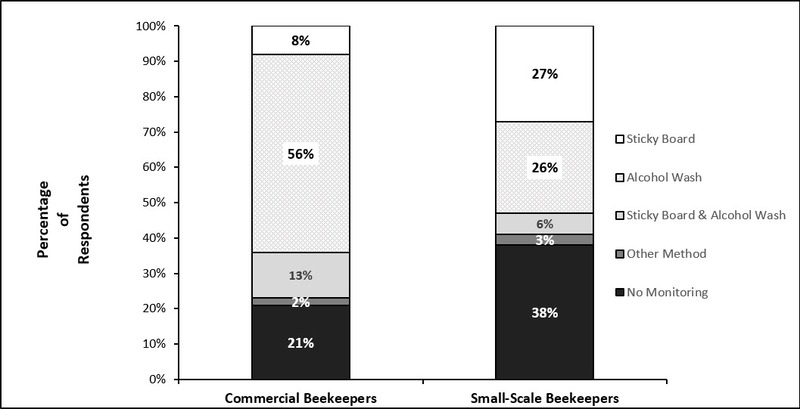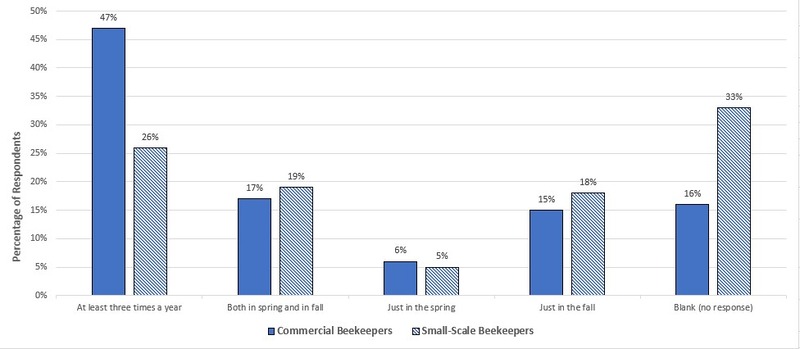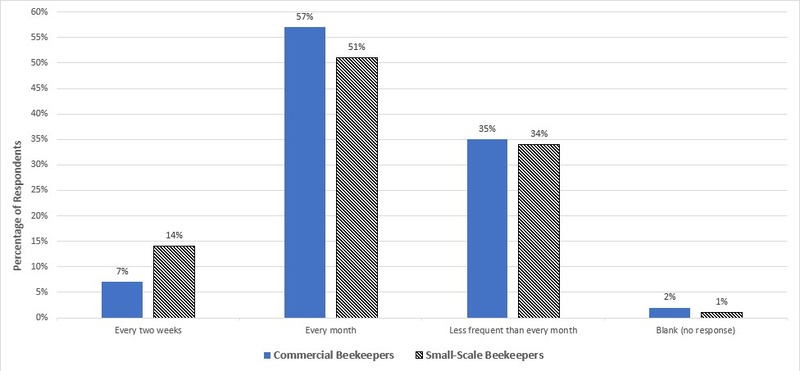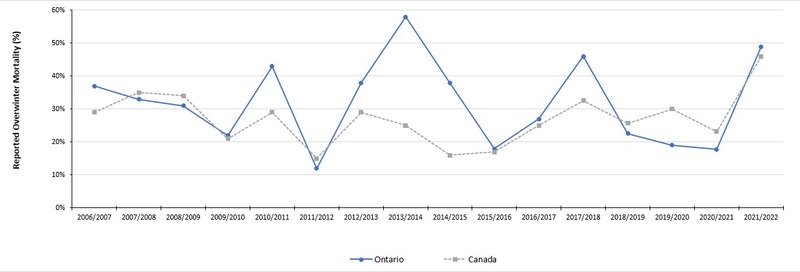2022 Apiculture winter loss report
2022 honey bee colony winter mortality
Overwinter mortality for 2021-2022 for commercial beekeepers operating in Ontario was estimated to be 49%, up significantly from the 18% estimated for the winter of 2020-2021.
The estimate for commercial beekeepers in Ontario was approximately 2% less than the estimated loss reported for small-scale beekeepers (51%).
The 2022 estimation for honey bee loss averaged between all of Canada was 46%.
Who we surveyed
In the spring of 2022, the survey was distributed via email to:
- 203 registered commercial beekeepers (defined as operating 50 or greater colonies)
- 2,466 registered small-scale beekeepers (defined as operating 49 or fewer colonies)
The survey was sent electronically to all registered beekeepers (commercial and small-scale) who provided the Ministry of Agriculture, Food and Rural Affairs (OMAFRA) with their email address. In 2022, OMAFRA distributed the survey to a larger proportion of registered small-scale beekeepers than previous survey years. For comparison, in 2021 the survey was distributed via email to all registered commercial beekeepers and to 400 randomly selected registered small-scale beekeepers. The increased surveying of small-scale beekeepers was due to early reports of high winter mortality by Ontario beekeepers in 2022.
The survey is voluntary and all responses are self-reported by beekeepers. Data is not verified by OMAFRA or any other independent body.
Responses were received from 124 commercial beekeepers and 658 small-scale beekeepers, which represents 29% of beekeepers who received the survey.
Of the beekeepers who were registered in Ontario as of December 31, 2021, responses were received from 54% of commercial beekeepers representing 62,558 colonies and from 22% of small-scale beekeepers representing 5,224 colonies (Tables 1 and 2). Combined, the responses represent 66% of the total number of registered colonies.
| Beekeeping regions | # of commercial beekeeper respondents | % of commercial beekeeper respondents | # of small-scale beekeeper respondents | % of small-scale beekeeper respondents |
|---|---|---|---|---|
| Central | 46 | 37% | 173 | 26% |
| East | 21 | 17% | 201 | 31% |
| North | 10 | 8% | 78 | 12% |
| South | 31 | 25% | 160 | 24% |
| Southwest | 16 | 13% | 42 | 6% |
| Not specified | 0 | 0% | 4 | 1% |
| Beekeeper type | # of full-sized colonies put into winter in fall 2021 | # of viable overwintered colonies as of May 15, 2022 | # of non-viable colonies as of May 15, 2022 | Overwinter mortality (%) |
|---|---|---|---|---|
| Commercial | 62,558 | 32,027 | 30,531 | 48.8% |
| Small-scale | 5,224 | 2,547 | 2,677 | 51.2% |
Results
The estimated overwinter honey bee mortality and the number of respondents varied by beekeeping region (Table 3). The majority of commercial beekeepers who responded to the survey were from the central and south beekeeping regions. These areas are known to have the greatest number of honey bee colonies in Ontario. Responses from small-scale beekeepers were largely from the central, east and south beekeeping regions (Table 1).
Commercial beekeepers reported the greatest losses in the north region while small-scale beekeepers reported the highest losses in the east region (Table 3). Mortality during the 2021-2022 winter was similar between the beekeeper groups, with the commercial beekeepers being 2.4 percentage points lower than small-scale beekeepers (Table 2).
| Beekeeping regions | # of commercial beekeeper respondents | Commercial beekeeper overwinter mortality (%) | # of small-scale beekeeper respondents | Small-scale beekeeper overwinter mortality (%) |
|---|---|---|---|---|
| Central | 46 | 49.5% | 173 | 48.5% |
| East | 21 | 38.1% | 201 | 55.6% |
| North | 10 | 66.2% | 78 | 48.9% |
| South | 31 | 51.0% | 160 | 49.7% |
| Southwest | 16 | 40.3% | 42 | 54.1% |
| Not specified | 0 | N/A | 4 | 50.0% |
| Total | 124 | 48.8% | 658 | 51.2% |
When respondents were grouped by operation size (number of colonies managed), the honey bee mortality during the winter of 2021-2022 ranged from 42.7% to 55.3% (Table 4). Beekeepers operating 501-1,000 colonies reported fewer honey bee colony losses (42.7%) than all other beekeeping operation sizes. The greatest number of survey respondents had beekeeping operations with fewer than 10 colonies and this group reported the highest overwinter honey bee mortality of 55.3%. Beekeepers with 10-49, 50-200, and >1000 colonies had high losses (49.2%, 51.1%, and 50.3% respectively). Beekeepers with 201-500 and 501-1,000 colonies also had high losses, but were lower than the other categories of beekeepers with 45.2% and 42.7% respectively.
| # of respondents | # of colonies reported in the fall of 2021 | Overwinter mortality (%) |
|---|---|---|
| 447 | <10 | 55.3% |
| 181 | 10-49 | 49.2% |
| 80 | 50-200 | 51.1% |
| 18 | 201-500 | 45.2% |
| 13 | 501-1,000 | 42.7% |
| 13 | >1,000 | 50.3% |
Main factors of bee mortality
Beekeepers were asked to report on what they believed were the main factors contributing to their overwinter honey bee mortalities; they were able to select as many reasons as they felt were applicable. These opinions may be based on observable symptoms or beekeeper experience, judgement or best estimate.
The most commonly reported factors influencing overwinter mortality (Table 5) by commercial beekeepers included:
- ineffective varroa control
- weak colonies in the fall
- weather
The most commonly reported factors influencing overwinter mortality (Table 5) by small-scale beekeepers included:
- weather
- weak colonies in the fall
- ineffective varroa control
32% of commercial beekeepers and 18% of small-scale beekeepers selected “other” for their suspected cause of colony loss. It is noted that 16% and 3% of the ‘other’ responses were attributed to suspected pesticide poisonings by commercial and small-scale beekeepers respectively. In 2021, OMAFRA received 10 in-season honey bee mortality incident reports. Incident reports were shared with the Ontario Ministry of Environment, Conservation and Parks and Health Canada if the report was suspected to be related to pesticide application during the active beekeeping season.
| Suspected cause(s) of colony loss | % of commercial beekeepers reporting | % of small-scale beekeepers reporting |
|---|---|---|
| Poor queens | 21% | 12% |
| Weak colonies in the fall | 35% | 28% |
| Weather | 34% | 30% |
| Starvation | 19% | 13% |
| Ineffective varroa control | 44% | 24% |
| Other | 32% | 18% |
| Don’t know | 28% | 21% |
| Nosema | 4% | 2% |
Management practices for pests and disease
Varroa mites (Varroa destructor)
In this survey beekeepers were asked how they monitored for varroa mite infestations (Figure 1) and which treatments were used at the beginning (spring), mid-season and the end (late summer/fall) of the 2021 beekeeping season (Table 6).

Accessible description for Figure 1
Proportion of beekeepers monitoring for varroa mites
Of the beekeepers who responded to the varroa mite monitoring question, 79% of commercial beekeepers and 62% of small-scale beekeepers stated they monitor for varroa mite infestation in their colonies. Of those, a number of monitoring methods were used, the most common being either an alcohol wash or a sticky board.
Some beekeepers used more than 1 method to monitor for varroa mites. When the response “other” was selected, some beekeepers reported that they visually checked their colonies for varroa mites or used the “sugar shake” method. However, neither of these methods is recommended or recognized as effective, as visually checking for mites is not proven to yield usable information and the sugar shake method can be unreliable and it is not tied to established thresholds for Ontario.
From the data, it appears that most (79%) of the commercial beekeepers represented by this survey are monitoring for varroa mites. However, this figure is down from the 87% of commercial beekeepers who reported they were monitoring for varroa mites in the 2020-2021 season. This is the second year in a row where the number of commercial beekeepers, who indicated that they are monitoring for varroa mites, has decreased. Compared to the 2020-2021 survey, the number of commercial beekeepers who do not monitor for varroa mites increased by 8%.
It is also very concerning that a high percentage (21% commercial and 38% small-scale) of beekeepers who responded to the survey reported no monitoring for varroa mites at all. These numbers represent a high proportion of beekeepers who are not monitoring for varroa mites. Ideally, 100% of beekeepers should monitor for varroa mites as monitoring, along with application of a treatment, is crucial for the management of this honey bee pest. Without the management of varroa mites, colonies are at a high risk of death and/or spreading varroa mites to other nearby colonies. Furthermore, research has demonstrated that inadequate varroa mite control is the primary cause of winter mortality in honey bee colonies in Ontario
These results demonstrate the need for further education/training of beekeepers and further messaging on best management practices and integrated pest management. Monitoring for varroa mites needs to improve as this is a key practice to assess colony health and to improve the survival of colonies going into the winter. It is not enough that beekeepers simply treat their colonies without knowing their varroa mite levels.
Frequency of monitoring for varroa mites
It is encouraging to see from the survey data that a good proportion of both commercial and small-scale beekeepers are sampling at least twice per season, and it is even more encouraging to see that there are both commercial and small-scale beekeepers sampling even more frequently at 3 times per year (Figure 2). A more detailed analysis of those beekeepers who sampled more than 3 time per year shows that 57% and 51% of commercial and small-scale beekeepers respectively sampled for varroa mites every month (Figure 3). At the same time there is room for improvement for both categories of beekeepers. Monitoring frequently, particularly as the beekeeping season progresses, is one of the most important management practices beekeepers can do to ensure they are applying their varroa treatments in a timely manner and ultimately preventing damaging levels of varroa from occurring.
This is the second year Ontario included a question on the frequency of monitoring.

Accessible description for Figure 2

Accessible description for Figure 3
Treatments used to control varroa mites
Ontario beekeepers use a variety of treatment options to manage varroa mites (Table 6). The survey asked beekeepers to report their use of varroa mite treatment options during 3 periods in 2021: spring, mid-season and late summer/fall. These periods are defined as:
- Spring – from the end of winter to the start of the honey flow
- Mid-season – from the start to the end of the honey flow
- Late summer/fall – when the last supers were removed for honey production to when colonies were managed for winter
In spring of 2021, the most common method of varroa mite treatment reported by commercial beekeepers was use of Apivar®, while in late summer/fall of 2021 both Apivar® (50%) and oxalic acid (44%) were most commonly used. The most common method of spring varroa mite treatment reported by small-scale beekeepers was use of Apivar® (22%) and Formic Pro (21%), while in late summer/fall of 2021 Apivar® (30%) and oxalic acid (30%) were the most common treatments used.
During the mid-season of 2021, a large proportion of commercial and small-scale beekeepers reported that they did not treat for varroa mites. Of the commercial and small-scale beekeepers who treated for varroa mites during the mid-season, the most common treatment method used by both groups was use of Formic Pro.
The least commonly used treatments by both commercial and small-scale beekeepers were Bayvarol®, ApiLifeVar and Hopguard II. It should be noted that ApiLifeVar and Hopguard II are relatively newer treatments that have been registered for use in Canada.
These results are encouraging as it demonstrates that Ontario beekeepers are likely rotating their miticides, which is an important strategy for delaying the onset of resistant populations of varroa mites. However, there may be some cause for concern from the data as some responses indicated the use of treatments mid-season that are not registered for use during a honey flow.
That being said, these unregistered, mid-season treatments may have been used by beekeepers who had removed their honey supers or were managing their colonies whereby they were not producing honey (such as nucleus colonies or pollination units). Also, the industry appears to be quite reliant on Apivar® as a control method for varroa mites. Should the Ontario industry see development of varroa mite resistance to amitraz (the active ingredient in Apivar®), it may seriously restrict beekeepers’ ability to control varroa mites, resulting in increased mortality of colonies in Ontario. While other chemical options are available many of them are temperature dependent (such as formic acid), which may factor into the timing and choice of treatment depending on the weather conditions during a particular season in Ontario.
As amitraz resistance has been documented in varroa mite populations in the USA, it is important to monitor its status in Canada. New compounds will be needed for varroa mite control in order to ensure there is a robust set of options available to beekeepers and to offer the opportunity to rotate treatments so that beekeepers can continue to incorporate effective integrated pest management practices in their beekeeping operation.
It should be noted that varroa mites in Ontario have established resistance (or reduced efficacy) to other compounds (for example, coumaphos, fluvalinate, flumethrin).
| Varroa mite treatment (active ingredient) | Spring 2021 % of commercial beekeepers | Spring 2021 % of small-scale beekeepers | Mid-season 2021 % of commercial beekeepers | Mid-season 2021 % of small-scale beekeepers | Late summer/fall 2021 % of commercial beekeepers | Late summer/fall 2021 % of small-scale beekeepers |
|---|---|---|---|---|---|---|
| Apistan® (fluvalinate) | 10% | 2% | N/A | N/A | 5% | 2% |
| CheckMite+™ (coumaphos) | 0% | 0% | N/A | N/A | 1% | 0% |
| Apivar® (amitraz) | 35% | 22% | N/A | N/A | 50% | 30% |
| Thymovar (thymol) | 1% | 1% | N/A | N/A | 4% | 2% |
| ApiLifeVar (thymol and essential oils | 0% | 0% | N/A | N/A | 1% | 0% |
| Bayvarol® (flumethrin) | 2% | 1% | N/A | N/A | 0% | 1% |
| 65% formic acid – 40 ml multiple application | 15% | 5% | N/A | N/A | 19% | 5% |
| 65% formic acid – 250 ml single application | 6% | 3% | N/A | N/A | 6% | 2% |
| Mite Away Quick Strips™ (formic acid) | 3% | 6% | 8% | 5% | 4% | 6% |
| Formic Pro (formic acid) | 15% | 21% | 27% | 18% | 15% | 20% |
| Oxalic Acid | 25% | 15% | N/A | N/A | 44% | 30% |
| Hopguard II (hop compounds) | 1% | 1% | 1% | 1% | 2% | 1% |
| Other | 7% | 3% | 17% | 6% | 4% | 2% |
| None | 14% | 25% | 46% | 60% | 1% | 9% |
Nosema spp. (N. apis and N. ceranae)
92% of survey respondents indicated that nosema treatment was not applied in the spring or fall of 2021 (Table 7). Nosema is a disease that has been identified to delay the development of honey bee colonies in spring and reduce the lifespan of individual honey bees, but has not been identified as a factor in colony mortality over winter
| Nosema treatment | Spring 2021 % of commercial beekeepers | Spring 2021 % of small-scale beekeepers | Fall 2021 % of commercial beekeepers | Fall 2021 % of small-scale beekeepers |
|---|---|---|---|---|
| Fumagillin | 6% | 7% | 7% | 7% |
| Other | 2% | 1% | 2% | 1% |
| None | 92% | 92% | 92% | 92% |
American foulbrood (Paenibacillus larvae)
The majority of commercial beekeepers who responded to this survey question had treated for American foulbrood (AFB) during spring 2021 (59%) and a little more than half had treated during fall 2021 (51%) with oxytetracycline. By comparison, 25% of small-scale beekeepers reported treating for AFB in the spring and in the fall (Table 8).
| American foulbrood treatment | Spring 2021 % of commercial beekeepers | Spring 2021 % of small-scale beekeepers | Fall 2021 % of commercial beekeepers | Fall 2021 % of small-scale beekeepers |
|---|---|---|---|---|
| Oxytetracycline | 59% | 25% | 51% | 25% |
| Tylosin | 0% | 0% | 1% | 0% |
| Lincomycin | 0% | 0% | 0% | 0% |
| Other | 2% | 0% | 1% | 0% |
| None | 39% | 75% | 48% | 75% |
Ontario’s overwinter mortality
The Canadian Association of Professional Apiculturists compiles overwinter mortality data provided by each province and publishes an annual report on national honey bee colony losses. Figure 4 compares Ontario’s overwinter mortality levels to that of Canada’s. The 2022 estimate for commercial beekeepers in Ontario (48.8%) was approximately 3% more than the estimation for bee loss averaged between all of Canada (45.5%).

Accessible description for Figure 4
Accessible image descriptions
Figure 1. Type of varroa mite monitoring method used by commercial and small-scale beekeepers in 2021.
Figure 1 shows the type of varroa mite monitoring method used by commercial and small-scale beekeepers in 2021. 8% of commercial beekeepers reported using the sticky board method, 56% used the alcohol wash method, 13% used both sticky board and alcohol wash, 2% used other methods, and 21% reported no monitoring for varroa mites. 27% of small-scale beekeepers reported using the sticky board method, 26% used the alcohol wash method, 6% used both sticky board and alcohol wash, 3% used other methods, and 38% reported no monitoring for varroa mites.
Figure 2. Frequency of varroa mite monitoring by commercial and small-scale beekeepers in 2021.
Figure 2 shows the frequency of varroa mite monitoring by commercial and small-scale beekeepers in 2021. Commercial beekeepers – 47% at least 3 times a year, 17% both in spring and in fall, 6% just in the spring, 15% just in the fall, and 16% did not respond to this question. Small-scale beekeepers – 26% at least 3 times a year, 19% both in spring and in fall, 5% just in the spring, 18% just in the fall, and 33% did not respond to this question.
Figure 3. Frequency of varroa mite monitoring by commercial and small-scale beekeepers in 2021 who reported monitoring at least 3 times a year.
Figure 3 shows the frequency of varroa mite monitoring by commercial and small-scale beekeepers in 2021 who reported monitoring at least 3 times a year. Commercial beekeepers – 7% every 2 weeks, 57% every month, 35% less frequent than every month, and 2% did not respond to this question. Small-scale beekeepers – 14% every 2 weeks, 51% every month, 34% less frequent than every month, and 1% did not respond to this question.
Figure 4. Overwinter mortality (%) reported by commercial beekeepers in Ontario (blue) and Canada (grey) from 2006-2007 to 2021-2022.
Figure 4 shows the percentage of overwinter mortality reported by beekeepers in both Ontario and Canada from 2007 to 2022. The reported overwinter mortality in Ontario and Canada (respectively) was the following: 2007 – 37% and 29%; 2008 – 33% and 35%; 2009 – 31% and 34%; 2010 – 22% and 21%; 2011 – 43% and 29%; 2012 – 12% and 15%; 2013 – 38% and 29%; 2014 – 58% and 25%; 2015 – 38% and 16%; 2016 – 18% and 17%; 2017 – 27% and 25%; 2018 – 46% and 33%; 2019 – 23% and 26%; 2020 – 19% and 30%; 2021 – 18% and 23%; 2022 – 49% and 46%.
Footnotes
- footnote[1] Back to paragraph Guzmán-Novoa, E., L. Eccles, Y. Calvete, J. McGowan, P. Kelly and A. Correa-Benítez (2010). Varroa destructor is the main culprit for the death and reduced populations of overwintered honey bee (Apis mellifera) colonies in Ontario, Canada. Apidologie 41(4): 443-450.
- footnote[2] Back to paragraph Emsen, B., E. Guzman-Novoa, M. M. Hamiduzzaman, L. Eccles, B. Lacey, R. A. Ruiz-Pérez and M. Nasr (2016). Higher prevalence and levels of Nosema ceranae than Nosema apis infections in Canadian honey bee colonies. Parasitol Res 115(1): 175-181.
- footnote[3] Back to paragraph Emsen, B., A. De la Mora, B. Lacey, L. Eccles, P. G. Kelly, C. A. Medina-Flores, T. Petukhova, N. Morfin and E. Guzman-Novoa (2020). Seasonality of Nosema ceranae infections and their relationship with honey bee populations, food stores, and survivorship in a North American region. Veterinary Sciences 7(3): 131.